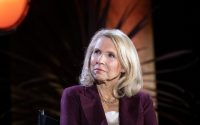Fed Meeting Today: What to Expect
Follow live updates as Federal Reserve officials announce their latest decision on interest rates.
Federal Reserve officials will announce their June policy decision on Wednesday, and they are widely expected to hold steady after 10 straight interest rate increases — taking a breather to see how the economy is shaping up 15 months into their fight against rapid inflation.
Prices have been increasing faster than the Fed would like for more than two years, but a report on Tuesday confirmed that the pace of overall inflation continues to cool. That doesn’t mean the Fed can declare victory: Once volatile food and fuel prices were stripped out, the data showed inflation remained stubbornly rapid.
Investors are betting that Fed officials will respond to the mixed picture by skipping an increase this month, even as they signal that they might lift rates in July.
Still, the outlook is very uncertain, and investors will be watching Wednesday’s Fed meeting closely for any hint at what could come next. Central bankers will release their rate decision and fresh economic forecasts at 2 p.m., followed by a news conference with Jerome H. Powell, the Fed chair, at 2:30 p.m. Here’s what to know about the decision.
Interest rates are at their highest since 2007.
Fed officials have raised interest rates sharply since March 2022, pushing them to just above 5 percent in the fastest series of rate increases since the 1980s.
The speed of adjustment is relevant because it takes months or even years for the effects of interest rate changes to fully trickle through the economy.
Given that, the economy is — most likely — feeling only part of the brunt of the Fed’s past moves. That increases the risk that the central bank could overdo it and slow growth by more than is strictly necessary to contain inflation if officials push forward without taking time to assess conditions.
Overshooting would have serious ramifications: Restraining the economy too aggressively would very likely cost jobs, diminishing financial security for many Americans.
But an incomplete policy response would also carry consequences. If rapid inflation drags on for years, consumers could come to see fast price increases as the norm, making them harder to stamp out without serious economic pain that causes higher unemployment down the road.
Skipping does not mean stopping.
If setting monetary policy is like a marathon, a pause now is like stopping for a water break — to stretch and take stock — rather than giving up on running altogether. Fed officials have been clear that while they may hit pause temporarily, they could lift rates again if needed.
“A decision to hold our policy rate constant at a coming meeting should not be interpreted to mean that we have reached the peak rate for this cycle,” Philip Jefferson, a Fed governor who is President Biden’s pick to be the central bank’s next vice chair, said in a speech last month. Instead, Mr. Jefferson said, skipping would “allow the committee to see more data.”
Tuesday’s inflation data probably kept officials on track to hold policy steady in June while teeing up a July increase, said Sarah Watt House, senior economist at Wells Fargo.
“They are going to have to walk a very fine line,” she said. “The U.S. economy continues to carry some pretty formidable momentum.”
Investors are on dot watch.
Every three months, the Fed releases a set of projections — the “dot plot” — that shows where each official expects interest rates to land by the end of the next few years. (The predictions are anonymous and are demarcated by little blue spots, hence the name.)
The dots come out alongside a set of projections for unemployment, inflation and growth. They will be released on Wednesday for the first time since March.
Some economists are expecting the Fed to pencil in slightly higher growth for the economy, slightly higher core inflation, and a slightly lower unemployment rate by the end of 2023. One complication is that officials will have had barely any time to update their projections in the wake of Tuesday’s Consumer Price Index report. Officials had until Tuesday evening to change their forecasts, but that meant they had just hours to factor in the new figures.
Investors are probably going to be most focused on how much higher interest rates are expected to rise this year. Many expect Fed officials to pencil in one more rate move — lifting the anticipated policy rate to a range of 5.25 percent to 5.5 percent at the end of 2023. But given the varied opinions on the central bank’s policy-setting committee, the predictions might be for even higher rates.
All eyes are on Jerome Powell.
Jerome H. Powell, the Fed chair, will give a news conference after the meeting. He may explain how central bankers are thinking about their path ahead for interest rates — and how officials will judge whether they have done enough to feel confident that inflation, now running at 4.4 percent by their preferred measure, is back on a path toward their 2 percent goal.
“The main message will be: A pause does not necessarily mean the end of the rate hiking cycle,” said Michael Feroli, chief U.S. economist at J.P. Morgan.


